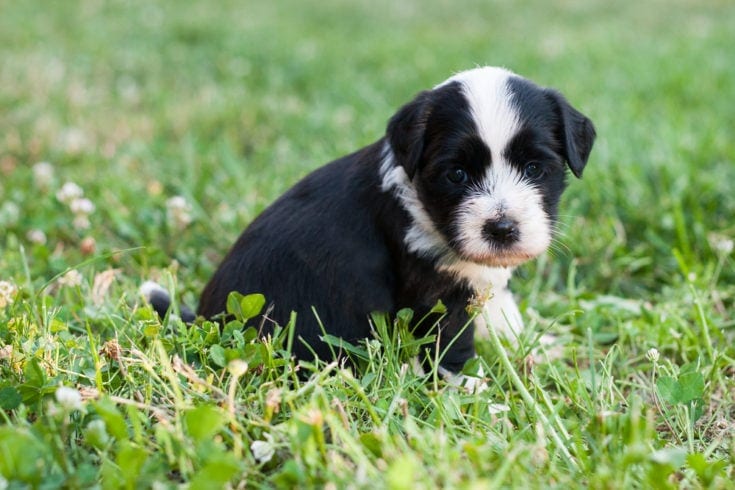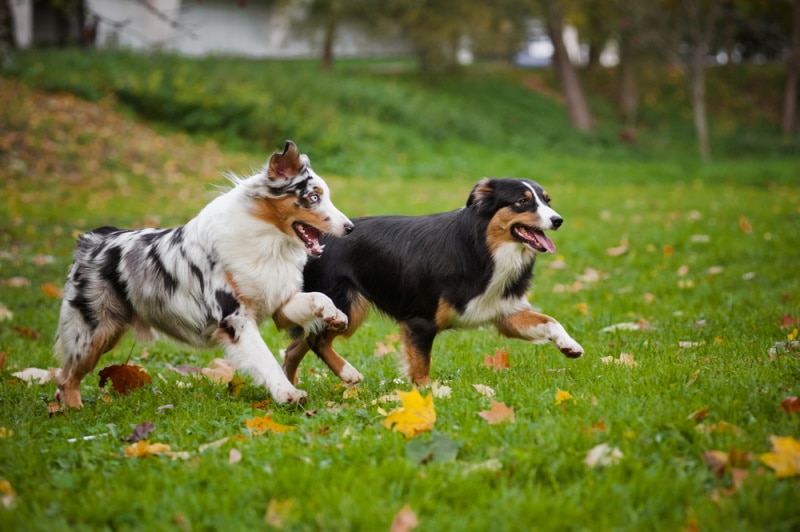
Click Below to Skip Ahead
The Tibetan Terrier is best described as a fluffy, loyal companion – and for good reasons! This medium-sized breed was developed to be a companion dog for all different people as they are adaptable and love their human owners. Underneath that shaggy mop-like coat is an energetic devoted canine friend who will stay with you through thick and thin.
This dog breed originates from the mountainous Lost Valley of Tibet and can be traced back 2000 years. The Tibetan Terrier was bred and raised in monasteries, staying by their Tibetan monk companions. They were also used as companions for the nomadic herders that crossed the rugged mountain terrain and watched over their tents at night. These days, their gentle and friendly temperament makes them poor guard dogs; however, the Tibetan Terrier excels at being therapy dogs.
Breed Overview
Height:
14 – 17 inches
Weight:
20 – 30 pounds
Lifespan:
12 – 16 years
Colors:
White, tricolor, gold, brindle, silver, black
Suitable for:
Active families with or without children; apartments or houses
Temperament:
Adaptable, people-loving, energetic, loyal, sensitive
Tibetan Terriers can make exceptional pets. They can fit in with single-person households, couples, or families with children. This breed also does well in apartments. Tibetan Terriers are happiest when close to their favorite humans and do not like being alone for long hours. Are you interested in understanding more about this lucky dog? Read on to learn more about the Tibetan Terrier.
Tibetan Terrier Characteristics
Tibetan Terrier Puppies

These dogs are primarily sold as household pets. If you want a Tibetan Terrier for dog shows or breeding, they can cost a lot more. You can ask breeders near your location if they have Tibetan Terriers or what is the waiting time to have one. You can also take a chance at a local shelter. There might not be a guarantee that this specific breed will be there, but you can consider changing a dog’s life.
Tibetan Terriers have an average lifespan of 10-15 years, which is why having one of these dogs is not a short-term commitment. You must take plenty of time for your dog, from regular exercise, annual vet checkups, and a lot of cuddling!
Temperament & Intelligence of the Tibetan Terrier
The temperament of the Tibetan Terriers is friendly, affectionate, loyal, and active. They are considered companion dogs, making them excellent pets for people who are looking for a loyal canine. While these dogs might be a slight challenge for novice owners due to their sensitivity level and intolerance to being left alone for long periods, they can quickly become part of the family with early training.
Tibetan Terriers have above-average intelligence. The combination of their intelligence and their desire to please their owners make them reasonably easy to train. As with all dogs, training should be done with a level of firmness and persistence. Since these dogs are intelligent, they can get bored quickly and act out their boredom by barking or even trying to escape if they are cooped up in a yard. The Tibetan Terrier loves being the center of attention!
Although these dogs were used as guards for nomadic Tibetan herders in the past, owners and breeders of the Tibetan Terriers have noted they do not make the best guard dogs in a modern setting due to their gentle nature. This breed starts off being mildly cautious of strangers, but they warm up to people quickly. However, this breed is a barker, so they can warn you if they hear something outside – although that “something” might be the neighbor’s cat!

Are These Dogs Good for Families? 👪
Yes, the Tibetan Terrier is an excellent pet for families. They love older children! With their gentle and energetic temperament, kids have a fun time playing with this long-haired pup! However, as with all dogs, young children should not be left unsupervised while playing with the family pet. Sometimes, children might pull on the dog’s ears or tail a bit too hard, which may lead to the dog getting defensive. Also, Tibetan Terriers can be a bit lively and might knock over a small child, hence why they are better suited for older kids.
While they can adapt to most living situations, an important thing to remember is that Tibetan Terriers do not do well when they are left alone for extended periods of time. They are quite sensitive and get lonely. If you are out of the house for most of the day for work or school, this breed will not do well.
Does This Breed Get Along with Other Pets?
With proper early socialization, the Tibetan Terrier can get along with other dogs. Make sure to have patience when introducing your Tibetan Terrier to another dog. Since this breed has a low prey drive, they should get along with other pets, like cats. As with all dogs, early socialization is the key to having a peaceful and fun multi-pet household.
Things to Know When Owning a Tibetan Terrier
Each dog has different needs and wants. The sign of a responsible pet owner is knowing the essential details needed for the particular dog. Here are some things to know about caring for a Tibetan Terrier.
Food & Diet Requirements 🦴
An adult Tibetan Terrier that gets the average amount of required exercise requires between just over a cup to under a cup and a half of high-quality dog food spread out over two meals daily. Dogs thrive on wet or dry food with animal-based protein as the primary ingredient.

Exercise 🐕
Tibetan Terriers have above-average energy levels. They will love to come with you on your daily walks or jogs. This breed needs to have about an hour of daily exercise. The exercise can be in different forms: a few 15-minute walks during the day or one long walk are both great ways to get your Tibetan Terrier out and about. Remember that this dog originates from a rugged and mountainous region of the world, so if you want to take this pooch on a hike, they will be able to handle the incline!
Training 🎾
This breed is both intelligent and mildly stubborn, which can either make training them easy or a small challenge. On the one hand, Tibetan Terriers want to please their owners; however, they can have a streak of stubbornness. Being patient, firm, and consistent with the training will be beneficial for both dog and owner.
Grooming ✂️
A distinguishable feature of the Tibetan Terrier is their long double coat: a wooly undercoat and wavy or straight topcoat. Their coats come in various colors, such as white, gold, brindle, silver, black, and even tricolor. If left untrimmed, the Tibetan Terrier’s coat can grow almost to the floor! This can be quite a cute look for your dog, but you must maintain the coat. If your dog runs around in nature, they might come back with burrs, twigs, and leaves entangled in their fur. Grooming them should be done once to three times weekly, depending on the length of the coat. This breed can also develop mats if left ungroomed. Mats can be harmful to the dog’s skin. For a Tibetan Terrier, a slicker brush will work best on their coat. Check this breed’s ear frequently. Dirt and ticks can hide in their ears and could remain unnoticed due to the long coat. On the positive side, despite the long coat, this breed does not shed much.

Health and Conditions 🏥
This dog is known for being hardy. However, all animals can develop health conditions during their life. Here are some of the issues to be aware of when owning a Tibetan Terrier.
Tibetan Terriers can develop minor eye conditions. Progressive retinal atrophy (PRA) is the deterioration of the eye and can lead to blindness. Lens luxation is when the lens is not positioned correctly in the eye. Vets could treat it with surgery or medication, but it might need to be removed if the case is too severe.
Although this condition is more common in larger dogs, Tibetan Terriers can develop canine hip dysplasia, which is when the hip joint loosens, causing pain and discomfort.
Some health issues are genetic and can get passed down through the dog’s parents. Reputable breeders should provide complete health records of the parents to show that no negative genetic health conditions are being passed on to your puppy.
Male vs Female
There is little difference between the male and female Tibetan Terrier. Both sexes are roughly the same size and weight, with adult females being slightly smaller. Both sexes also possess the same temperament and intelligence level.
3 Little-Known Facts About the Tibetan Terrier
1. Tibetan Terriers are not really terriers.
True terriers are known for their tendency to dig in the ground to unearth vermin and rodents, which is something the Tibetan Terrier does not do. They were given the name “terrier” due to their size.
2. In Tibet, these dogs were known as “luck bringers.”
Owning one of these dogs was thought to bring a person good luck. This was probably due to their devotion and loyalty towards their owners. Because the Tibetan Terrier was lucky, they were never bought or sold; they were given as gifts.
3. Dr. Agnes Greig was the first European to own a Tibetan Terrier.
In 1922, Dr. Greig performed an operation on a Tibetan patient. To show gratitude, the patient gifted her with a female Tibet Terrier. Dr. Greig was later gifted with a male, and soon she began breeding Tibetan Terriers.
Final Thoughts
If you are the right fit, a Tibetan Terrier will prove to be a loyal and fun companion. If you are not away from home often during the day, can provide at least an hour of daily exercise for this pooch, and do not mind doing weekly grooming, then the Tibetan Terrier could be a fantastic new pet. They are lively, friendly, dedicated, and love people. The Tibetan Terrier can quickly become your best friend.
Featured Image Credit: Antranias, Pixabay








